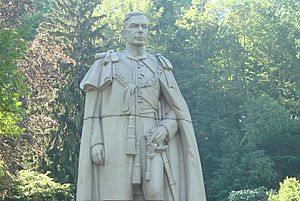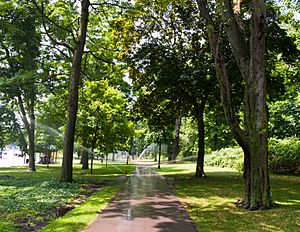Queen Victoria Park facts for kids
Queen Victoria Park is a beautiful park in Niagara Falls, Ontario, Canada. It sits right across from the amazing American and Canadian Horseshoe Falls. This park was created in 1885 and opened in 1888. It's managed by the Niagara Parks Commission and is like the heart of the fun tourist area around Niagara Falls.
The park is famous for its incredible flower displays, especially daffodils and roses when they are in bloom. Many flowers are planted in a special "carpet-bedding" style, which means they look like a giant, colorful carpet! Queen Victoria Park is also where the yearly winter Festival of Lights takes place, making it sparkle and shine.
Park History
Early Days by the Falls
Before it became a park, this area was actually part of the Niagara River bed. A long time ago, in 1678, a person named Father Louis Hennepin is thought to be one of the first visitors to explore this spot. People didn't really start settling here until the early 1800s.
In 1818, William Forsyth, who came from Buffalo, settled here. By 1822, he had built the first stairs down to the river below the falls. He also built the Pavilion Hotel, one of the first big buildings in the area. Later, Thomas Clark and Samuel Street bought the land. They started building near a spot called Table Rock.
Another person, Thomas Barnett, built a museum nearby in 1827. The north part of the park, where Oakes Garden Theatre is now, had a fancy hotel called the Clifton House, built in 1833 for wealthy travelers.
A man named Samuel Zimmerman, who made a lot of money building canals and railways, bought a large piece of land across from the American Falls. He planned to build a huge estate, but he sadly died in a train accident in 1856. Only two small gatehouses and a fountain were built.
In the late 1850s, Saul Davis came to Canada and opened a museum next to Barnett's, called Table Rock House. Barnett and Davis became big rivals. They both built stairways down to the falls and tried to get tourists to visit their museum. This area became known as The Front because it was a tricky place for tourists. People would sometimes be forced to pay for things they didn't want!
By 1859, Barnett built a larger building where the Victoria Park Restaurant is today. But his rivalry with Davis continued into the 1870s.
The idea of making this area a park first came up in 1873. A Canadian politician, Edmund Burke Wood, thought it would help stop the bad behavior happening there. At first, the government didn't want to pay for it. But by 1885, a committee led by Sir Casimir Gzowski suggested a government-run park that would be free for everyone.
This idea finally convinced the government. The Queen Victoria Niagara Falls Park Act was passed in March 1887. Old, ugly buildings were torn down, and the grounds were cleaned up. Queen Victoria Park officially opened to the public on May 24, 1888, which was Queen Victoria's birthday.
Park Growth and Changes (1888-1945)

When the park first opened, it was free to enter. You only paid if you wanted a tour guide. However, the park wasn't making enough money. So, in 1890, the park commission allowed a railway company to build a train line from Chippawa to Queenston. This electric train started running in 1893. Its power plant was the first hydroelectric power plant on the Canadian side of the falls.
The railway brought many visitors to the park, and by 1895, the park started making a profit. The commission then took over the "Behind The Sheet" attraction at Table Rock, which is now called Journey Behind the Falls. They also began making the park more beautiful. In 1896, they opened their first greenhouse to help grow plants for the park, which had very few trees when it first opened.
Thomas Barnett's old museum was taken down in 1903. A new restaurant, called the Refectory (now the Victoria Park Restaurant), opened in 1904. To earn more money, the commission also allowed three more hydroelectric power plants to be built between 1904 and 1918.
New buildings like a restaurant (1926) and an administration building (1927) were added. The Clifton Hotel north of the park burned down in 1898, and its replacement also burned down in 1932.
Harry Oakes, a rich mining businessman, bought the land where the Clifton Hotel used to be. He gave it to the Niagara Parks Commission. The beautiful Oakes Garden Theatre was built there and opened in September 1937. This was part of a plan to make the entrance to Canada, near the Upper Steel Arch Bridge, look nicer.
Just four months later, in January 1938, the Arch Bridge was destroyed by a severe ice jam. The Rainbow Bridge was then built further down the river and opened in 1941. The old Arch Bridge area eventually became known as the Rainbow Gardens.
In 1932, the Queenston/Chippawa Railway stopped its lease, which caused financial problems for the park commission. It took almost five years to settle how much money the railway should be paid. This, along with the start of World War II, made it hard for the commission to make many improvements to the park until the late 1940s.


